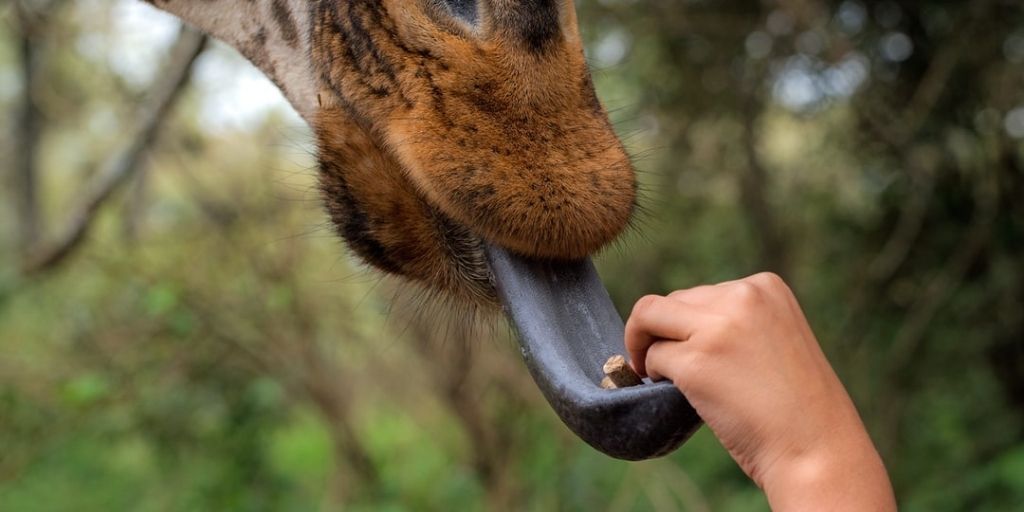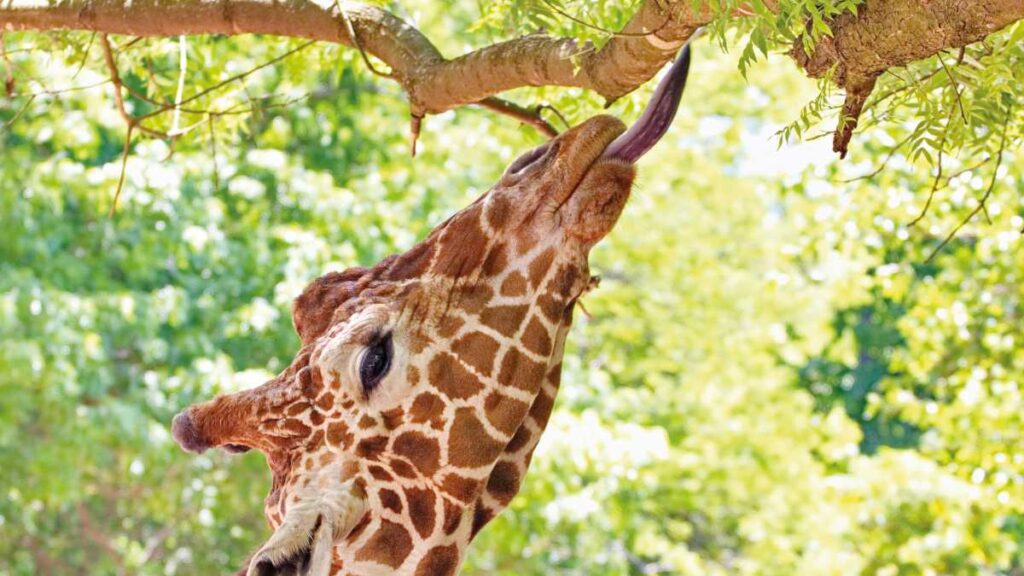Giraffes have black tongues as a form of protection against the sun. The dark coloration is due to a high concentration of melanin, the same pigment responsible for human skin color. This dark pigment helps prevent their tongues from getting sunburned during their frequent exposure to the sun while they browse for food among thorny trees and bushes.
The melanin in their tongues acts as a natural sunblock, shielding them from harmful UV rays. This adaptation is crucial for giraffes as they spend a significant amount of time feeding on leaves and twigs from trees, using their tongues that can extend up to 18-20 inches (45-50 centimeters) to reach high branches.
Additionally, the dark coloration may also serve to prevent injuries or infections, as giraffes often use their tongues to grasp and pull leaves from thorny acacia trees, and the dark pigmentation can protect against potential abrasions or scratches from thorns.
What defines giraffes’ tongues and their unique coloration?

Giraffes are known for their distinctive tongues, which can grow to be about 18 to 20 inches long. Their tongues are prehensile, meaning they are adapted for grasping and manipulating objects, particularly leaves from tall trees, which is their primary source of food.
The unique coloration of giraffes’ tongues is attributed to a high concentration of melanin, the pigment responsible for skin and hair coloration in animals. Their tongues often appear bluish-black or purple, which is thought to provide protection against sunburn due to exposure while foraging for food among thorny acacia trees.
Additionally, the dark coloration could serve as a form of protection against UV radiation, allowing giraffes to spend extended periods with their tongues exposed while feeding on leaves without experiencing damage from the sun.
This adaptation helps them reach leaves that other herbivores cannot access, thereby reducing competition for food within their habitat.
How do black tongues benefit giraffes’ survival?
The black tongues of giraffes offer several benefits that aid in their survival:
Protection from sunburn
The dark pigmentation in their tongues, believed to be due to a high concentration of melanin, provides protection against harmful UV rays. As giraffes spend a considerable amount of time foraging among thorny trees and bushes, the dark color helps prevent sunburn and potential damage to their tongues.
Foraging advantages
Giraffes primarily feed on the leaves of acacia trees, which are covered in thorns. Their long, agile, and prehensile tongues enable them to pluck leaves from the trees without being harmed by the thorns. The dark coloration of their tongues might also provide some resistance to abrasions or minor injuries while feeding.
Adaptation for feeding
The coloration might serve as camouflage, making their tongues less visible to potential predators while they are feeding. This reduced visibility could be advantageous in avoiding detection, especially when their long necks are stretched out in exposed areas.
Reduced competition
The ability to consume leaves from tall trees gives giraffes access to food sources that many other herbivores cannot reach. This minimizes competition for food within their habitat and allows giraffes to thrive in environments where such food sources are abundant.
What is the evolutionary significance of giraffes’ black tongues?

The evolutionary significance of giraffes’ black tongues is linked to their adaptation to their environment and their unique feeding habits. Several factors contribute to the importance of their black tongues from an evolutionary perspective:
Foraging Adaptation
Giraffes primarily feed on the leaves of tall trees, especially acacia trees, which often have thorns. Their tongues are not only long but also prehensile and tough, enabling them to navigate around the thorns and strip leaves from branches.
The dark coloration of their tongues might offer protection against sunburn and abrasions while foraging among thorny vegetation.
UV Protection
The dark pigmentation, likely due to high melanin content, provides defense against harmful ultraviolet radiation. Giraffes spend a significant amount of time with their tongues exposed while feeding.
Furthermore, the black coloration helps prevent sunburn, which could be particularly crucial in their habitat, where shade might not always be available.
Survival Advantage
Giraffes’ long necks and tongues allow them to access food sources that are out of reach for many other herbivores. The black tongues might contribute to their success in exploiting these high, often more nutritious, food sources, minimizing competition for resources.
Camouflage
While feeding in the open, having a dark tongue might make it less conspicuous to potential predators. This reduced visibility might offer a slight advantage in avoiding detection and predation while the giraffe’s head is high up in the trees.
These adaptive traits likely evolved over time as giraffes adapted to their specific ecological niche, where they needed to reach high foliage efficiently while dealing with thorny plants and exposure to sunlight.
FAQ’s
Why is a giraffe black?
Giraffes have black tongues primarily due to a high concentration of melanin, offering protection against sunburn while foraging among thorny trees.
What are the facts about giraffes’ tongues?
Giraffes possess prehensile tongues, approximately 18 to 20 inches long, adapted to grasp and manipulate leaves, often appearing bluish-black or purple due to their high melanin content.
Can giraffes see color?
Yes, giraffes have excellent color vision, similar to humans, and can perceive a wide range of colors.
What is the real color of a giraffe?
Giraffes have a patchy coat pattern with a base color ranging from light tan to dark brown, characterized by irregular spots or patches that can be shades of orange, chestnut, or nearly black.
What animal has a purple tongue?
The giraffe is known for having a purple or bluish-black tongue, which is a distinctive characteristic among animals.
Is a black giraffe a real thing?
No, a “black giraffe” typically refers to the coloration of their tongues or their patches, but the giraffe’s main body color varies within shades of tan, brown, and spots of different hues rather than being entirely black.
Final Words
Giraffes’ black tongues showcase remarkable evolutionary adaptations. These elongated, prehensile organs allow access to high foliage, essential for survival in their habitat. The dark pigmentation, possibly rich in melanin, shields against sunburn while foraging among thorns. This unique trait minimizes competition for resources and may offer subtle camouflage from predators during feeding.
Over time, these evolutionary advantages, aiding in feeding efficiency and protection, have likely contributed significantly to giraffes’ successful adaptation to their environment, highlighting the intricate interplay between form, function, and survival in the natural world.
